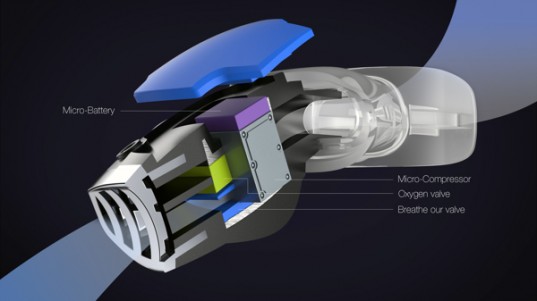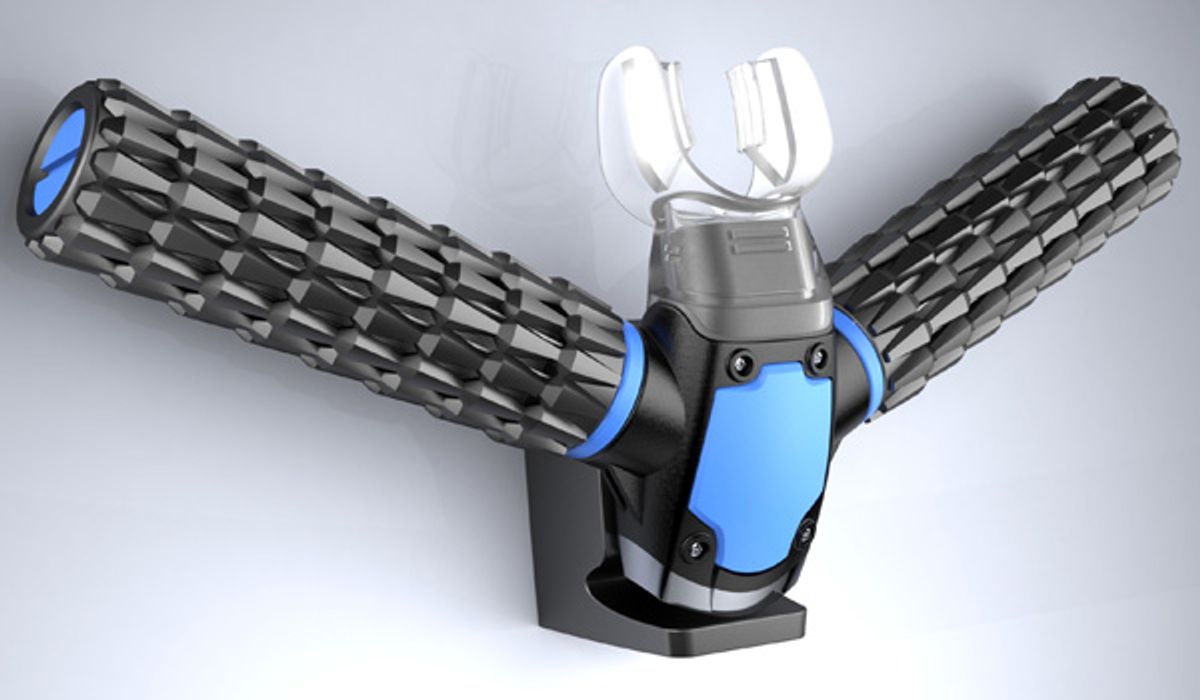In November 2013, South Korean designer Jeabyun Yeon unveiled his concept for a "Portal Oxygen Respirator" dubbed Triton, a device that would allow people to breather underwater "simply by biting it," at the Samsung Art and Design Institute (SADI) graduation exhibition:
South Korean designer Jeabyun Yeon just unveiled a conceptual scuba mask that would allow divers to breathe underwater without air tanks. The mask, called the Triton, consists of two branching arms designed to serve as "gills" that extract oxygen from the water and deliver breathable air directly into their wearer's lungs. Instead of hauling around heavy scuba equipment, swimmers could simply bite down on a plastic mouth piece.

Yeon's concept proved popular, and in March 2014 the web site Inhabitat published an article about the nifty design. While that article correctly described the Triton as a "conceptual scuba mask" and noted that "the design is just a concept" that may "someday be turned into a commercial product," the article's headline ("Triton Scuba Mask Transforms Divers into Human Fish") misled some readers into believing that the Triton was a fully developed, workable, real product.
An IndieGogo page dedicated to raising funds for the project explains how the Triton gills supposedly work:
Triton employs cutting-edge technology to produce 'artificial gills'. The Microporous Hollow Fiber makes breathing underwater possible.
The holes of the threads are smaller than water molecules, they keep water out and let oxygen in. The micro compressor then extracts and stores the oxygen — allowing you to breathe naturally and revel in your underwater freedom.
We are using a very powerful modified micro compressor, it compresses oxygen and stores the extracted oxygen in a storage tank. The micro compressor operates through a powerful modified lithium-ion battery.
However, as more skeptical reports have noted, the Triton is far more concept than product, and not necessarily a concept that will ever be realizable:
I'm not sold on the Triton. My biggest issue with it is that it would just have to filter so much water to provide all the oxygen a human needs for a single breath. The average human need 500mls of air with every breath; going in, the air has a 21% oxygen concentration and a 16% concentration coming out, for a total of ~25mls of oxygen intake with every breath. Scientific literature places the concentration of oxygen at 6mg/L of ocean water so the Triton would have to go through ... about 6L of water for each breath (assuming our lungs can scrub almost all the oxygen in the air which they don't)? I don’t really think it can do that.
That being said, finding a way to take oxygen out of seawater is a great idea. But Yeon needs to make this thing go through a lot of sea water very fast before it's actually usable for diving
Yeon uploaded a video on 20 February 2016 supposedly showing a working prototype of a set of Triton gills, but given the number of cuts in the video (such that the diver is never seen fully underwater for an extended period of time and could simply be holding his breath), it's not possible to determine if the product shown actually works as claimed:
After the release of the promotional video, more articles expressed some of the same doubts about the viability of such a device, and more:
There are several raised by experts and commentators about the device:
1) The device has to be able to extract enough oxygen from the water to allow you to actually breath. This is possible in theory however as pointed out in an article on Deep Sea News in 2014 (when the device first came to light as a concept) it requires not only an incredibly efficient ability to extract the oxygen – which the designers say is down to a new Microporous Hollow Fiber — but also water has to be forced through the device at upward of five liters every 15 seconds which could only be achieved with a pump bigger than the whole Triton design.
2) Next is the issue of storing the gas in a chamber — this would require a compressor and battery "order of magnitude more efficient than anything on the market today". The makers claim on the website that they have a "very powerful modified micro compressor" but again without any real proof.
3) Let's say they’ve managed to crack those two issues the next one is the ability to deliver the oxygen to you in the right amount at the right pressure to be able to breathe. This is possible as we see it in open-circuit Scuba systems and in Closed Circuit Rebreathers however, again, there is no technology on the market right now that can achieve such a feat in such a small design.
4) Finally there is the video, on face value it looks like there is a working unit, however on close inspection you can see that it is made up of several short clips where the person seems to be getting progressively more negatively buoyant (probably due to expelling air from their lungs to create the "bubbles" from the device) and no clip ever shows a person underwater for longer than one minute. As we know from Freediving that is not even a difficult breath-hold for most people.
All-in-all the possibility of a device such as Triton is not beyond the realm of possibility at some point; sadly, though, the challenges faced by the designers just do not seem to be reasonably solved with technology available today. The designers would have had to have developed 3 or 4 incredibly efficient and compact new technologies to make this possible.
Other commentators began question whether the Indiegogo campaign to fund development of the Triton gill device might not be a scam, given the extreme scientific unlikelihood that such a device could be built with existing technology and the lack of evidence for Triton's having produced anything beyond a mere concept:
Right now, an Indiegogo campaign for a device that its makers claim is "the future of underwater breathing" is raking in cash — more than $600,000 at the time of this post, $100,000 of which poured in over just 24 hours.
It's easy to see the appeal of the handheld device, called the "Triton." Diving equipment is heavy and complicated. Meanwhile, the Triton looks seductively simple and the campaign says it "allows you to breathe underwater."
But despite the slick crowdfunding campaign, there's no real evidence that this device actually works, multiple experts told Tech Insider.
One of them is Neal Pollock, a research associate at the Center for Hyperbaric Medicine and Environmental Physiology at Duke University Medical Center, and the research director for the Divers Alert Network — a non-profit organization that helps divers in medical emergencies and promotes dive safety.
"In concept it sounds very good and it's very exciting," Pollock tells Tech Insider, but "I would not encourage anyone pulling out a wallet."
For the makers of Triton to prove they've invented a device that can actually do what they say it can, Pollock and other experts want to see more evidence; the crowdfunding campaign and Triton website simply don't provide enough to go on.
Regardless, Pollock notes the technological challenges involved in creating a device like Triton are so vast that "it's not realistic, it's science fiction."
On 1 April 2016, Triton published an update announcing the release of a new video showing the product in action. They also disclosed that the Triton requires the use of 'liquid oxygen' cylinders, and that they had decided to refund the donations of all the backers who had contributed to so far and launch a new campaign:
Inside of each Triton, the artificial gills utilize “liquid oxygen”, which combined with the other components allow users to breathe underwater, which you can see in the video above. We will release more information about the ‘liquid oxygen’ cylinders and safety strap.
Note that the “liquid oxygen” cylinders won’t last forever so we plan to make it possible for backers to purchase and exchange cylinders through our website. They will come in packs of 1, 3 and 5, and we’ll list prices as soon as they are finalized. We’re also working on a solution to make them refillable.
We wanted to share it at the beginning of the campaign but were hesitant because we also wanted to protect our intellectual property. Our success and the positive comments we have received have made it clear that these details are important for our backers to understand.
We launched this campaign to build a community of people who are excited to bring Triton to life, and we are committed to making sure our backers feel confident in our efforts. After careful consideration and in light of this new information, we have decided to refund all Triton backers and launch a brand new campaign.

